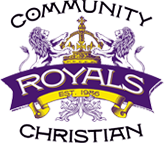Mathematics Department
Pre-Algebra - Instructor: Mr. Cox - Beginning with a six-week review of arithmetic skills, this course quickly moves to an introduction to basic algebra skills: signed numbers, percents, like terms, order of operations, equations and expressions. This course also presents a strong intro into geometry with angles, triangles, perimeter, area and volume. First level exercises in statistics, base 2, and unit multipliers is also included. (Saxon Algebra 1/2)
Algebra I - Instructor: Mrs. Wimer - Complete Algebra I course covering signed numbers, equations, polynomials, linear graphing, coordinate graphing, word problem applications, abstract expressions, equations, and inequalities. (Saxon Algebra I)
Algebra II - Instructor: Ms. Hodges - Prerequisite: Algebra I - 2nd level algebra skills that include fractional exponents, quadratic equations, complex numbers, logarithmic equations, word problem applications, systems of equations, rectangular and polar graphing. (Saxon Algebra 2)
Honors Algebra II - Instructor: Ms. Hodges - Prerequisite: Saxon Algebra I - This course is designed for advanced students who are capable of a more rigorous course at an accelerated pace. The standards for this course provide the foundation for students to pursue a sequence of advanced mathematical studies from Pre-Calculus to Advanced Placement Calculus.
Geometry - Instructor: Mr. Ohsfeldt - A study of geometric figures, polygons, area and volume, logic, reasoning and proofs, while reviewing Algebra I skills. (Saxon Geometry)
Pre-Calculus - Instructor: Mrs. Wimer - Prerequisite: Honors Algebra II
AP Calculus: Must have completed Pre-Calculus.
The AP Calculus AB course focuses on students’ understanding of calculus concepts and provide experience with methods and applications. Through the use of big ideas of calculus (e.g., modeling change, approximation and limits, and analysis of functions), each course becomes a cohesive whole, rather than a collection of unrelated topics. Both courses require students to use definitions and theorems to build arguments and justify conclusions. The courses feature a multirepresentational approach to calculus, with concepts, results, and problems expressed graphically, numerically, analytically, and verbally. Exploring connections among these representations builds understanding of how calculus applies limits to develop important ideas, definitions, formulas, and theorems. A sustained emphasis on clear communication of methods, reasoning, justifications, and conclusions is essential. Teachers and students should regularly use technology to reinforce relationships among functions, to confirm written work, to implement experimentation, and to assist in interpreting results.
